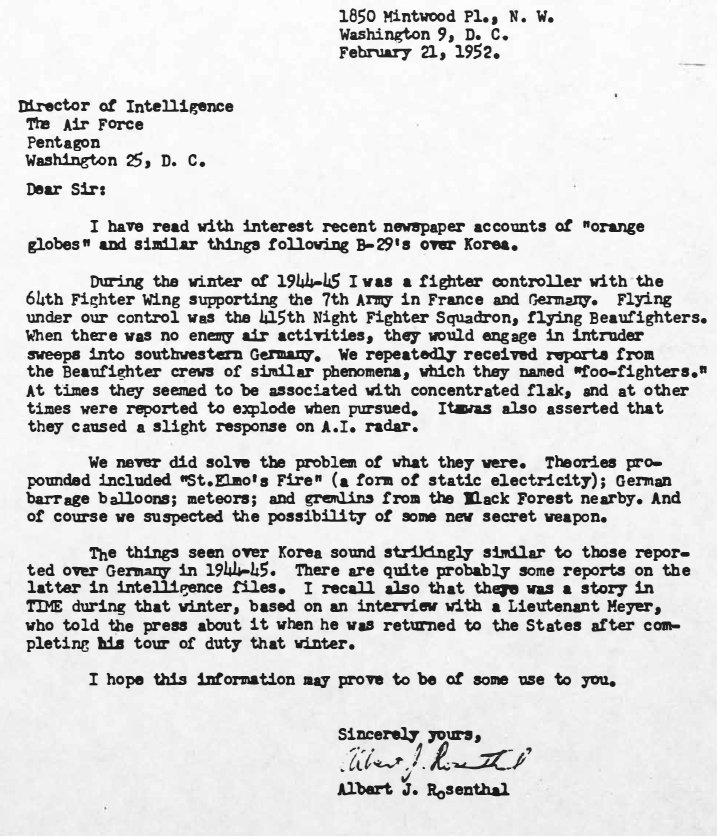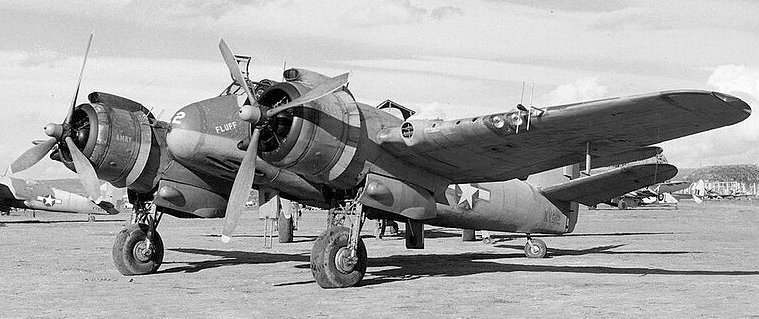ACUFO-1944-00-00-SOUTHWESTGERMANY-1
On February 21, 1952, Albert J. Rosenthal, of Washington D.C. wrote a letter to the Director or Intelligence of the U.S. Air Force at the Pentagon in Washington D. C.
He explained he read with interest recent newspaper accounts of “orange globes”; and similar things following U.S. B-29 bombers over Korea.
He explained that during the winter of 1944 - 1945 he was a fighter controller with the 64th Fighter Wing supporting the 7th Army in France and Germany. Flying under their control was the 415th Night Fighter Squadron, flying Beaufighters night fighters. When there was no enemy air activities, they engaged in intruder sweeps into southwestern Germany, and then they repeatedly received reports from the Beaufighter crews of similar phenomena, which they named “foo-fighters.”
Rosenthal explained that at times they seemed to be associated with concentrated flak, and at other times they were reported to explode when pursued. It was also asserted that they caused a slight response on the onboard radar sets.
Rosenthal indicates that they never found out what they were; theories propounded included “St.Elmo's Fire”, a form of static electricity; German barrage balloons; meteors; “and gremlins from the Black Forest nearby”; of course they also suspected the possibility of some new secret weapon.
| Date: | Winter 1944 - 1945 |
|---|---|
| Time: | Night. |
| Duration: | ? |
| First known report date: | 1952 |
| Reporting delay: | Day, 8 years. |
| Country: | Germany |
|---|---|
| State/Department: | |
| City or place: | Southwestern Germany |
| Number of alleged witnesses: | Several. |
|---|---|
| Number of known witnesses: | ? |
| Number of named witnesses: | 0 |
| Reporting channel: | Colleague of witnesses by letter to the Pentagon. |
|---|---|
| Visibility conditions: | Night. |
| UFO observed: | Yes. |
| UFO arrival observed: | ? |
| UFO departure observed: | ? |
| UFO action: | Sometimes explode when chased. |
| Witnesses action: | Sometimes pursuit. |
| Photographs: | No. |
| Sketch(s) by witness(es): | No. |
| Sketch(es) approved by witness(es): | No. |
| Witness(es) feelings: | Puzzled. |
| Witnesses interpretation: | St. Elmo fire or German devices, unexplained. |
| Sensors: |
[X] Visual: Several.
[ ] Airborne radar: [ ] Directional ground radar: [ ] Height finder ground radar: [ ] Photo: [ ] Film/video: [ ] EM Effects: [ ] Failures: [ ] Damages: |
|---|---|
| Hynek: | NL |
| Armed / unarmed: | Armed, machine guns and 20 mm cannon. |
| Reliability 1-3: | 2 |
| Strangeness 1-3: | 2 |
| ACUFO: | Insufficient information. |
[Ref. arl1:] ALBERT J. ROSENTHAL:

|
1850 Mintwood Pl., N. W.
Washington 9, D. C.
February 21, 1952.
Director or Intelligence
The Air Force
Pentagon
Washington 25, D. C.
Dear Sir:
I have read with interest recent newspaper accounts of “orange globes” and similar things following B-29's over Korea.
During the winter of 1944-45 I was a fighter controller with the 64th Fighter Wing supporting the 7th Army in France and Germany. Flying under our control was the 415th Night Fighter Squadron, flying Beaufighters. When there was no enemy air activities, they would engage in intruder sweeps into southwestern Germany. We repeatedly received reports from the Beaufighter crews of similar phenomena, which they named “foo-fighters.” At times they seemed to be associated with concentrated flak, and at other times were reported to explode when pursued. It was also asserted that they caused a slight response on A.I. radar.
We never did sole the problem of what they were. Theories propounded included “St.Elmo's Fire” (a form of static electricity); German barrage balloons; meteors; and gremlins from the Black Forest nearby. And of course we suspected the possibility of some new secret weapon.
The things seen over Korea sound strikingly similar to those reported over Germany in 1944. There are quite probably some reports on the latter in intelligence files. I recall also that there was a story in TIME during that winter, based on an interview vith a Lieutenant Meyer, who told the press about it when he was returned to the States after completing his tour or duty that winter.
I hope this information may prove to be of some use to you.
Sincerely yours,
Albert J. Rosenthal
[Ref. bgd1:] BARRY GREENWOOD:
On February 21, 1952, the Air Force Intelligence Service received a letter from one Albert Rosenthal, from Washington (archived at CAUS): “During the winter of 1944-45, I was an instructor combatant with the 64th Air Wing of the 7th Army in France and Germany. Under our authority, we had the 415th Night Fighter Wing. When there was no enemy air activity, it carried out penetrations into the southwest of Germany. We continually received reports from crews of similar phenomena which they called “Foofighters”. They sometimes seemed to be linked to heavy anti-aircraft fire, and, at times, appeared to explode when chased. It was also said that a faint echo was picked up on the AI radar.
We have never solved the problem of their nature. Proposed theories include “St. Elmo's fires” (a form of static electricity), enemy screen balloons, meteorites, or Gremlins from the nearby Black Forest. Finally, of course, we suspected the use of a new “secret weapon”.
[Ref. prt1:] JAN ALDRICH - "PROJECT 1947":
On February 21, 1952, Air Force Intelligence received a letter from one Albert Rosenthal of Washington, D.C. (In CAUS files):
“During the winter of 1944-45 I was a fighter controller with the 64th Fighter Wing supporting the 7th Army in France and Germany. Flying under our control was the 415th Night Fighter Squadron, flying Beaufighters. When there was no enemy air activities, they would engage in intruder sweeps into southwestern Germany. We repeatedly received reports from the Beaufighter crews of similar phenomena, which they named 'foo-fighters.' At times they seemed to be associated with concentrated flak, and at other times were reported to explode when pursued. It was also asserted that they caused a slight response on A.I. radar.”
“We never did solve the problem of what they were. Theories propounded included 'St Elmo's Fire' (a form of static electricity); German barrage balloons; meteors; and gremlins from the Black Forest nearby. And of course we suspected the possibility of some new secret weapon.”
[Ref. jsn1:] JEAN-CLAUDE SIDOUN:
This author cites:>/p>
During the winter [early December 1944] I was a combat instructor with the 64th Air Wing supporting the 7th Army in France and Germany. We had the 415th night fighter squadron under our authority. When there was no enemy air activity, it made penetrations into southwest Germany. We continually received reports from the crews of luminous aerial phenomena they called Foo-Fighters. The latter seemed to be linked to the heavy AA fire and, at certain times, appeared to explode when chased. It was also said that a faint echo was picked up on radar. However, we never solved the problem of their nature.
The author indicates that this comes from a letter from Albert Rosenthal sent in February 1952 to the Intelligence Service of the United States Air Force, according to “Dossier OVNI, secrets, réalités No. 2 , M. Cavendish pub., 1998, page 30.”
The Bristol Type 156 “Beaufighter”, nicknamed “Beau”, was a British multi-role aircraft developed during WWI. It was originally conceived as a heavy fighter variant of the Bristol Beaufort torpedo bomber; it proved to be an effective night fighter, which came into service with the Royal Air Force (RAF) during the Battle of Britain.
Originally, armament consisted of four 20mm cannons and six 0.303-in machine-guns but many variants were built; for example, versions had the ability to additionally carry eight rocket projectiles, some had a Vickers 'K' gun, Beaufighter TF.Mk X was used for anti-shipping operations.
The Beaufighter Mk VIF was fitted with the Mark VIII radar.
Below: Beaufighter Mk VIF of the 415th Night Fighter Squadron.

|
The Beaufighters served with the US Army Air Force until the end of the war, but most were replaced by the P-61 “Black Widow” beginning in December 1944.
The indirect testimony is not very detailed, but generally corroborated by the other case files in this catalog, including official documents.
We note that Rosenthal evokes a slight response on the onboard radars; instead, contemporary documents indicate occasional echœs on ground stations radar sets, who then direct planes towards these targets.
Insufficient information.
* = Source is available to me.
? = Source I am told about but could not get so far. Help needed.
| Main author: | Patrick Gross |
|---|---|
| Contributors: | None |
| Reviewers: | None |
| Editor: | Patrick Gross |
| Version: | Create/changed by: | Date: | Description: |
|---|---|---|---|
| 0.1 | Patrick Gross | April 14, 2024 | Creation, [arl1], [bgd1]. |
| 1.0 | Patrick Gross | April 14, 2024 | First published. |
| 1.1 | Patrick Gross | May 23, 2024 | Addition [jsn1]. |
| 1.2 | Patrick Gross | July 19, 2024 | Addition [prt1]. |